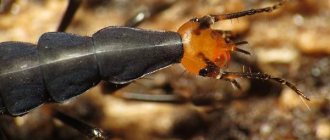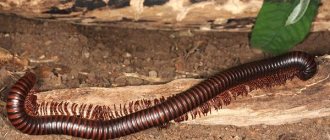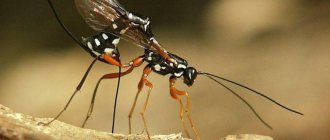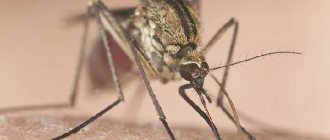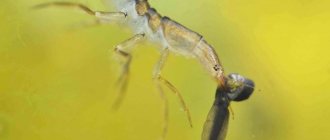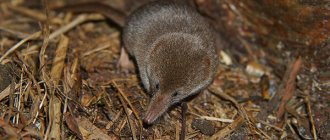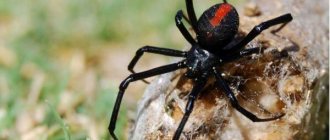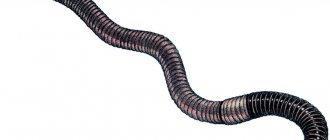Description and features
The diving beetle received a gift from nature with an elongated, streamlined body, which helps it move well in the water. On average, specimens grow to 45-50 mm. The color of individuals is most often nut-brown or black.
The body of a beetle is a fixed structure of three elements: the head, thorax and abdomen. The forelimbs, of which there are two pairs, help the beetle linger under water. It grabs onto plants with hooks with which these legs are “equipped.”
The hind limbs are adapted for swimming and are covered with hairs, and their design is similar to small oars. Even the swimming style itself is similar to how a boatman rows oars, the two hind limbs move simultaneously.
The insect also has well-developed wings, which it does not use often. The swimming beetle flies only when food runs out or its favorite water reservoir dries up. The eyes of the diving beetle are unusual. They are made up of nine thousand facets, small ordinary eyes.
This eye structure helps the insect to navigate very well under water and distinguish between stationary and moving objects. The organs for grasping food are very well developed - the jaws are sharp and powerful, which makes it possible to eat prey alive.
Swimmers spend most of their time underwater, but they must swim to the surface from time to time because they need fresh air to breathe. On the abdomen of the swimmer there are special-purpose holes through which oxygen enters and then goes through the trachea to all parts of the body.
In order to replenish the resources of necessary oxygen, the beetle swims to the surface and pushes its abdomen outward. The oxygen replenishment procedure should take place at least once every 15 minutes. Beetles use air not only for breathing; a special bag helps them control their descent and ascent.
Kinds
About 600 species of different swimming beetles are known. The following species live in mid-latitudes:
1. Fringed swimmer . The most common and famous species, as well as the largest specimen. It is distinguished by the presence of an ocher-colored border, which decorates the entire body of the insect. A grown individual reaches 30-35 mm. Such beetles are common in Europe and America, Japan, Transcaucasia and the Sakha Republic.
2. Latissimus swimmer . The largest and rarest species of diving beetles. Adults grow up to 45 mm. They like to settle in bodies of water with clean water and high oxygen content, which is why the population is declining. Listed as an endangered species in the Red Books of several states.
3. Phalarope or striper. It is found in bodies of water with stagnant water, where there is a lot of its favorite food - tadpoles. It is smaller in size than the fringed diving beetle; an adult is 12-16 mm. It can be found wherever there is standing water, as well as small fish and tadpoles, which it grabs and devours with extraordinary speed.
When a life-threatening situation arises, the beetle releases a toxic milky liquid that covers its body. An unpleasant-smelling liquid scares away potential enemies, and they lose interest in it. Beetles are common in Russia, the northern territories of the African continent, the islands of the Sea of Japan and East Asian countries.
4. Diving . These beetles are quite compact in size, growing up to 0.5 cm, and this is their maximum length. Among this type of insect the most familiar are:
- The flat diving fish is a strong and well-fed individual, covered with long and densely growing hairs. The sides and front of the back have an uneven, rough surface;
- The swamp dive is smaller in size even than the flat dive. The maximum value is up to 3.5 mm. It can be identified by the presence of red-red spots located in the eye area. Despite the name, such an individual can be found in forest lakes and slow-flowing rivers. Inhabits vast territories from the Atlantic Ocean to Sakhalin.
5. Prudovik . Lives in wild ponds covered with vegetation. The color is dirty brown, the wings are covered with a pattern in the form of transverse notches.
Enemies of the swimmer
The consequence of the appearance of beetles in fish farms or artificial reservoirs can be the extermination of large numbers of fish. However, there are also creatures who eat the swimming beetle in a pond with great pleasure - these are various invertebrates, large fish, birds and mammals.
In moments of danger, swimmers secrete an unpleasant-smelling liquid, which has a deterrent effect.
The larvae of diving beetles also have enemies. We are talking about an aquatic parasitic insect - an ichneumon fly, which has the strange name of prestwichia. Having discovered the egg of a diving beetle, the female ichneumon lays her eggs in it. The resulting parasite larva will eat the insides of the victim's egg until it turns into a pupa. The already formed adult equestrian is released into the world.
Video
Swimming beetle is a collective name for aquatic insects belonging to the order Coleoptera. In nature, there are 4 thousand species, 300 live in Russia. Beetles can fly and swim perfectly. They spend most of their lives in water. They prefer ponds and lakes with standing water. Adult swimmers and their offspring are active predators. They attack fish and fry, tadpoles, mosquito larvae, and mollusks. In fish farming areas, the appearance of a swimming beetle becomes a real disaster.
Lifestyle and habitat
In nature, it is very rare to find living creatures that can both fly and stay under water for a long time. The swimming beetle lives only in places where there is fresh water and there is no strong current. These beetles fully confirm their name by their way of life. 90% of the time the predator is underwater, tracking prey or resting. Rest is most often combined with replenishing oxygen supplies.
You can see how the beetle lies on the surface with its abdomen up, so it fills its organs with air so that it can then stay under water for some time and return to hunting.
The water beetle swims magnificently, and it’s rare that you won’t see it in any pond. Thickets along the shores of forest lakes and small lakes in water meadows often collect huge numbers of insects. The fast current apparently creates noticeable interference when hunting small predators, and they also have problems when they need to take in air, which is why the habitat is stagnant water.
Although the wings of an insect are adapted for flight, in order to take off, it needs to get to land. The beetle moves on land rather awkwardly, walking in a waddle, swaying from foot to foot. Swimming beetles leave their favorite body of water only in the event of drought and other natural causes of shallowing of the water area.
An interesting feature: swimmers are also active at night. They continue to hunt even in the dark; at this time of day they fly from one body of water to another. Beetles do not see very well at night, which is why they often get into trouble, mistaking surfaces with glare for water surfaces. When diving on wet and shiny objects, swimmers often break.
Its small size and conspicuous appearance should make the diving beetle an accessible prey item for other predators, but it has a defensive weapon in its arsenal. When danger arises, the beetle's glands release a cloudy white liquid that has a disgusting, pungent odor and a sharp, unpleasant taste. This deters even larger predators and is a guarantee of safety.
Relations within the community are quite complex, if not cruel. When two individuals meet, they start a battle for territory, biting and beating each other. Swimming beetles survive the winter cold in cozy burrows, which they make for themselves as frost approaches. At this time of year they sleep.
Nutrition
The swimming beetle in the photo looks like a harmless insect. But this is very far from reality, since the insect is a voracious predator. The greatest threat to all inhabitants of the reservoir is not even an adult, but a larva of the swimming beetle . This is one of the most merciless types of creatures that inhabit ponds.
The large crescent-shaped jaws are not used by the cub for chewing prey, but with their help the larva holds its trophy like pincers. Through them, a very toxic substance comes from the predator’s esophagus, which causes paralysis in the prey.
The next portion of the substance, which is ejected from the esophagus, decomposes the victim’s tissues to a jelly-like state, and the larva begins to absorb this substance. She has an immoderate appetite and resumes hunting as soon as she has dined. Interestingly, food for the larvae is only what moves; the larvae do not attack stationary objects.
Adult beetles are as insatiable as their larvae. Small fish, tadpoles, fry and other insects are not a complete list of what the diving beetle eats . A hungry beetle can attack frogs and fish, the size of which is close to 10 cm. Of course, one beetle cannot cope with it.
But the wounded fish attracts other swimmers with the smell of its blood, and then the attack occurs as a group. The beetles do not kill their trophy, but try to eat it alive, gnawing off piece by piece.
A large number of beetles can cause significant damage to fish populations in water bodies. Swimming beetles and fry live in the same aquatic environment, which sometimes leads to the complete disappearance of fish, since the fry are devoured by an insatiable animal.
Lifestyle
Beetles easily float to the surface of lakes and ponds, but it is more difficult for them to descend. At the bottom of reservoirs, swimmers hold on to stones or plants with special hooks on their front legs.
The Coleoptera insect is active at night. In the dark, it hunts or looks for a new home. Adult insects can fly considerable distances in one trip. Before the flight, the diver climbs ashore, clears the intestines of food debris and fills the air sacs with oxygen. When the body becomes lighter, the insect takes off. When searching for a body of water, it uses its visual organs. When numerous eyes notice the shine, the beetle dives to the surface of this object. Sometimes the insect lands on glass or metal surfaces. A strong impact on such materials can kill a swimmer.
During the cold season, small predators hide in cracks or burrow into the soil. Some varieties overwinter in the egg or larval phase. Beetles that live in Europe spend the cold season plunging into adult diapause. When young insects emerge from the pupa in the autumn, they remain overwintering in the litter. Divers can swim actively in cool water if they have enough oxygen in their air sacs. When the surface of the reservoir freezes completely, the swimmers burrow into the silt, where they sleep until it warms up.
Pests can settle on insects: water mites, nematodes and parasites. The dark colors allow the swimmers to hide from those who hunt them. The main enemies of beetles:
- birds;
- small mammals;
- large fish.
Swimmers eat any food with protein. They can also feed on dead fish. In the absence of small prey, waterfowl beetles can attack frogs and fish that are 2-3 times their size. Its relatives help the swimming swimmer cope with large prey. After bites, the victim's blood spreads in the aquatic environment and attracts other beetles. About a dozen divers gather around a fish or frog and eat the prey in pieces.
Reproduction and lifespan
The swimming beetle is an oviparous insect, like many Coleoptera. With the first warm days, when the water in reservoirs warms up, the beetles leave their wintering place and begin to look for water spaces in which mating could occur. Since the whole process takes place under water, it often ends tragically for the female.
Having chosen a suitable female, the male sits on her back, securing himself on the slippery surface. He is helped in this by two suction cups located on his front legs. Moreover, the female spends the entire mating process under water, and her partner, who is on top, is able to breathe. The tip of the abdomen, protruding above the surface of the water, helps him in this.
The resistance preceding crossing and the process itself continue for a longer time than the insect is accustomed to doing without breathing. For this reason, situations arise when the partner may not have enough air and die. This is most likely to happen when the female has to mate with several males in a row.
If the process goes without any unpleasant incidents, the female attaches the clutch to the stems of plants, piercing them with the ovipositor, and lays eggs there one after another. One such clutch can include up to one hundred eggs, the size of which reaches 5 mm. The development of the swimming beetle is not a quick process. The larvae will appear only after 2-5 weeks, depending on weather conditions and water temperature.
The swimmer can remain in the larval stage for up to 2 months, then it emerges from the water and begins to move on land to dig a hole for pupation. The adult beetle will emerge from the pupa in 20-35 days. He will spend about another week in his hole, waiting until his covers harden, and then he will go looking for water.
Insects live on average about one year in the wild. Those who like to place a beetle in a home aquarium can expect it to live there for 2-3 years.
Interesting Facts
There is an opinion that the diving beetle chooses weak and sick inhabitants of the pond as victims for attack, that is, it is, in fact, an orderly. The diving beetle usually does not show hostility towards a person who finds himself in the same water pool. But the bite is very painful even for a person.
The sharp pain associated with the bite may go away after some time, but swelling occurs in the bitten area, completely disappearing after 14-20 days. The wounded area must be washed, treated with disinfectants, bandaged and a cold compress applied.
Most often, beetles show aggressiveness towards those who try to catch them and pick them up. At home, experts do not recommend keeping swimming beetles and ornamental fish in the same aquarium, as the predator will attack them and can seriously injure them.
Undesirable neighborhood
Having settled in a decorative pond, a predatory beetle attacks decorative fish and other inhabitants. Owners of ponds are faced with a difficult problem: how to get rid of the swimming beetle in the pond? The least labor-intensive way is to have crucian carp, which actively destroy the larvae of the swimming beetle. Another option is to temporarily install a pump or fountain that creates movement of the water mass. The insect prefers stagnant bodies of water, so it will leave its shelter and go in search of a better habitat.
If the above methods do not work, then all that remains is to drain the water, clean and disinfect the bottom. This will destroy the adults and larvae of the beetle. After treatment, water is poured in and new inhabitants are released.
Danger to humans
You can encounter a predatory beetle while swimming in a lake or in your own pool. The insect shows aggression towards humans extremely rarely. The bite is painful, but does not pose a threat to health. The swimming beetle bites in the water if it feels threatened. The pain from the skin puncture remains for several minutes. After some time, the wound swells and a lump may form. The beetles are not poisonous, so there is no allergic reaction.
The victim must be given first aid:
- wash the wound;
- treat with an antiseptic (iodine, hydrogen peroxide);
- apply a bandage;
- apply ice to relieve swelling.
Attention. Often, those who pick it up without the necessary skill get bites from the swimming beetle.
